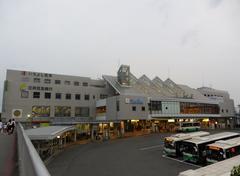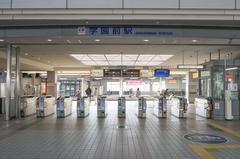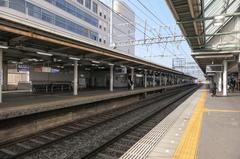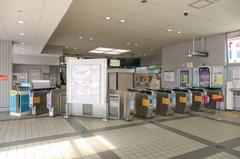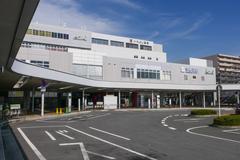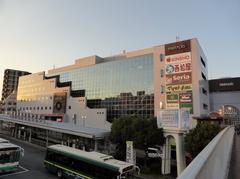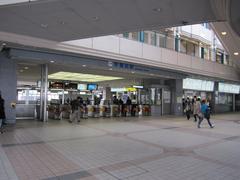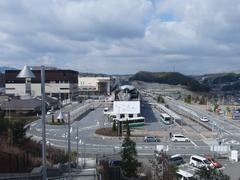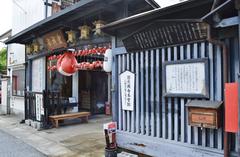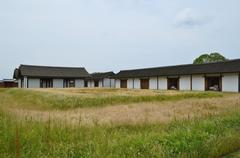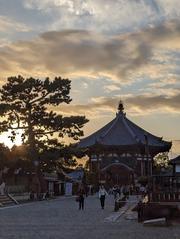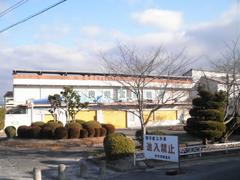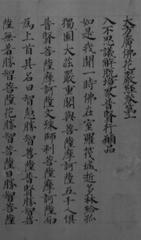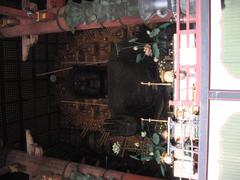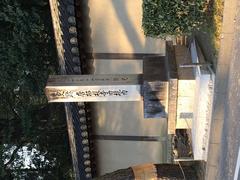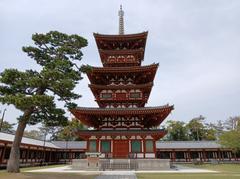
Gakuen-Mae Station: Guide to Visiting Hours, Tickets, and Nara’s Historical Sites
Date: 14/06/2025
Introduction
Gakuen-Mae Station (学園前駅), located in Nara, Japan, serves as a crucial entry point for visitors eager to explore the city’s renowned historical and cultural sites. Operated by Kintetsu Railway on the Kintetsu Nara Line since 1964, the station is not only a transportation hub for students attending nearby universities but also a convenient gateway for tourists seeking access to UNESCO World Heritage sites, traditional districts, museums, and vibrant shopping areas. This comprehensive guide details the station’s visiting hours, ticketing options, accessibility, nearby attractions, and practical visitor tips to ensure a seamless and enriching experience in Nara. For the latest transit updates and travel assistance, download the Audiala app.
Contents
- Station Overview: Hours, Ticketing, and Accessibility
- Getting to Gakuen-Mae Station & Best Times to Visit
- Station Layout and Facilities
- Connectivity: Buses, Taxis, and Bicycle Access
- Nearby Attractions
- Cultural Highlights and Local Experiences
- Practical Visitor Tips & Safety
- FAQ
- Visual Aids and Further Exploration
- Sources
Station Overview: Hours, Ticketing, and Accessibility
Operating Hours
- Daily Hours: Approximately 5:00 AM to midnight, in line with Kintetsu Railway’s schedules.
- Ticketing Services: Automated machines (multilingual) and staffed counters available during station hours.
- IC Card Compatibility: Accepts ICOCA, PiTaPa, Suica, and other major IC cards. (Kintetsu Railway Official Site)
Ticket Options
- Single Tickets: Purchase at machines or counters. Example: Gakuen-Mae to Osaka Namba is about 560 yen.
- Discount Passes: Kintetsu Rail Pass and Kintetsu Rail Pass Wide offer unlimited Kintetsu travel for a set period.
- Note: The Japan Rail Pass does not cover Kintetsu services.
Accessibility
- Barrier-Free Design: Elevators, ramps, tactile paving, and bilingual signage throughout the station.
- Accessible Restrooms: Facilities for wheelchair users and families.
- Staff Assistance: Available during all operating hours.
Getting to Gakuen-Mae Station & Best Times to Visit
Access Routes
- From Kansai International Airport: JR line to Namba, then Kintetsu Nara Line to Gakuen-Mae; total travel time ~70 minutes.
- From Osaka Namba: Direct express or local trains, ~30–40 minutes.
- From Kyoto: Transfer at Yamato-Saidaiji Station, approximately one hour.
Best Times to Visit
- Spring (March–May): Cherry blossoms and mild weather.
- Autumn (September–November): Colorful foliage and cultural festivals.
- Weekdays: Less crowded than weekends or university term times.
(Travel Japan Journal, MyTravelBuzzG)
Station Layout and Facilities
- Platforms: Two island platforms serving four tracks, with overhead concourses accessible via elevators, escalators, and stairs.
- Ticket Gates: Main gate on the upper concourse connects to North and South Exits.
- North Exit: Leads to residential areas and educational institutions.
- South Exit: Connects to commercial zones, bus stops, and taxi stands.
- Facilities: Restrooms (including accessible and nursing rooms), convenience stores, vending machines, ATM (international card support), coin lockers, climate-controlled waiting areas.
Connectivity: Buses, Taxis, and Bicycle Access
Buses
- Nara Kotsu Local and Loop Buses: Depart from the South Exit, connecting to Nara Park, Todaiji Temple, Heijo Palace Site, and other attractions.
- Fares: Typically around 210 yen per ride.
- Schedules: Posted in Japanese and English at the bus terminals.
Taxis
- Taxi Stand: Located at the South Exit for easy, flexible onward travel.
Bicycle Facilities
- Bicycle Parking: Available near both exits.
- Rental Options: Electric-assisted bicycle rentals can be arranged at nearby stations.
Nearby Attractions
Educational Institutions
- Nara Women’s University and Nara University of Education: Contribute to the station’s bustling, academic environment.
Historical and Cultural Sites
- Nara Park: Famous for its free-roaming Sika deer and scenic beauty. Open year-round.
- Todaiji Temple: UNESCO World Heritage Site, home to the Great Buddha. Open daily, 7:30 AM–5:30 PM. Admission: 600 yen.
- Kofuku-ji Temple: Iconic five-story pagoda, open daily, 9:00 AM–5:00 PM. Museum admission: 700 yen.
- Kasuga Taisha Shrine: Renowned for its lantern festivals.
- Heijo Palace Site: UNESCO World Heritage, featuring reconstructed gates and gardens.
- Naramachi Historic District: Edo-period merchant district with preserved townhouses, museums, and shops.
- Nara National Museum: Buddhist art collections. Open 9:30 AM–5:00 PM. Admission: 520 yen.
- Irie Taikichi Memorial Museum of Photography: Showcases local photographic history. Open 10:00 AM–5:00 PM, closed Mondays. Admission: 500 yen.
- M!Nara Shopping Mall: Modern shopping and dining, open 10:00 AM–9:00 PM.
(Japan Wonder Travel, Live Japan, MATCHA)
Cultural Highlights and Local Experiences
Historical Significance
Nara, Japan’s first permanent capital, boasts ancient temples, shrines, and city planning modeled after the Tang dynasty. Many of its sites are UNESCO World Heritage designated, reflecting their importance to Japanese culture.
Religious Traditions
Temples like Todaiji and Kofukuji remain active places of worship and host annual rituals and festivals, such as Kasuga Taisha’s Mantoro Festival.
Tea Ceremony and Local Workshops
- NARA Visitor Center & Inn: Offers traditional tea ceremonies and cultural workshops in English.
- Other Experiences: Pottery, indigo dyeing, and sake brewery tours are available through local providers.
(Sarusawa Nara, Nara Experience)
Cuisine
- Local Specialties: Miwa somen, narazuke pickles, persimmon leaf sushi, kudzu starch dishes, and Nara sake.
- Dining: From casual cafes in Naramachi to kaiseki multi-course meals and the historic Nara Hotel bar.
Souvenirs
- Omiyage: Deer-themed goods, traditional crafts, and regional sweets are popular gifts.
Practical Visitor Tips & Safety
- Luggage Storage: Not available at Gakuen-Mae Station; use coin lockers at Kintetsu Nara or JR Nara.
- Visitor Center: NARA Visitor Center & Inn near Kintetsu Nara Station provides maps, multilingual support, and travel advice.
- Etiquette: Bow respectfully when feeding deer and observe silence at religious sites.
- Weather: Prepare for hot, humid summers and cool winters; rainy season in June.
- Accessibility: Most attractions are barrier-free, but some historic sites have steps or uneven ground.
- Tour Options: Guided walking and cycling tours, as well as hands-on workshops, can be booked in advance.
- Best Seasons: Cherry blossoms in spring, autumn foliage, and hydrangea/firefly viewing in June.
FAQ
Q: What are the visiting hours for Gakuen-Mae Station?
A: Approximately 5:00 AM to midnight daily.
Q: Are tickets and IC cards available at the station?
A: Yes, automated machines and staffed counters offer ticket sales and IC card support.
Q: Is the station accessible for travelers with disabilities?
A: Yes, elevators, ramps, tactile paving, and accessible restrooms are provided.
Q: How do I reach Nara’s major historical sites from the station?
A: Use local buses or short train rides to reach Nara Park, Todaiji, Kofuku-ji, and more.
Q: Where can I find luggage storage?
A: At larger stations such as Kintetsu Nara and JR Nara.
Q: Are guided tours available?
A: Yes, several providers offer guided tours and cultural experiences departing from or near the station.
Visual Aids
-
Images:
- Gakuen-Mae Station entrance with bilingual signage
- Nara Park deer
- Todai-ji Temple’s Daibutsuden
- Naramachi historic lanes
- M!Nara Shopping Mall exterior
-
Maps:
- Interactive map linking Gakuen-Mae Station to Nara’s key attractions
-
Accessibility:
- Alt tags such as “Gakuen-Mae Station entrance – Nara historical sites” and “Todai-ji Temple Daibutsu hall – Nara sightseeing”
Explore More
Summary & Key Visitor Insights
Gakuen-Mae Station is a modern, accessible hub that seamlessly connects visitors to the depth and beauty of Nara’s historic and cultural landscape. With direct train and bus access to ancient temples, traditional neighborhoods, and vibrant shopping and museum districts, it is an ideal starting point for any Nara adventure. To enhance your experience, plan your visit during the cherry blossom or autumn foliage seasons, utilize larger stations for luggage storage, and embrace local customs and cuisine. For real-time transit updates and insider tips, use the Audiala app and consult official tourism platforms. Whether you’re a student, commuter, or traveler, Gakuen-Mae Station invites you to discover Nara’s timeless heritage and contemporary charm. (Visit Nara, Wikipedia, Japan Wonder Travel)
Sources and Further Reading
- Kintetsu Railway Official Site
- Visit Nara
- Wikipedia
- Japan Wonder Travel
- MATCHA
- Sarusawa Nara
- Live Japan
- Travel Japan Journal
- Inside Kyoto
- Wanderlog
- Sarusawa Nara - June Activities
- Nara Experience
- Japan Switch


